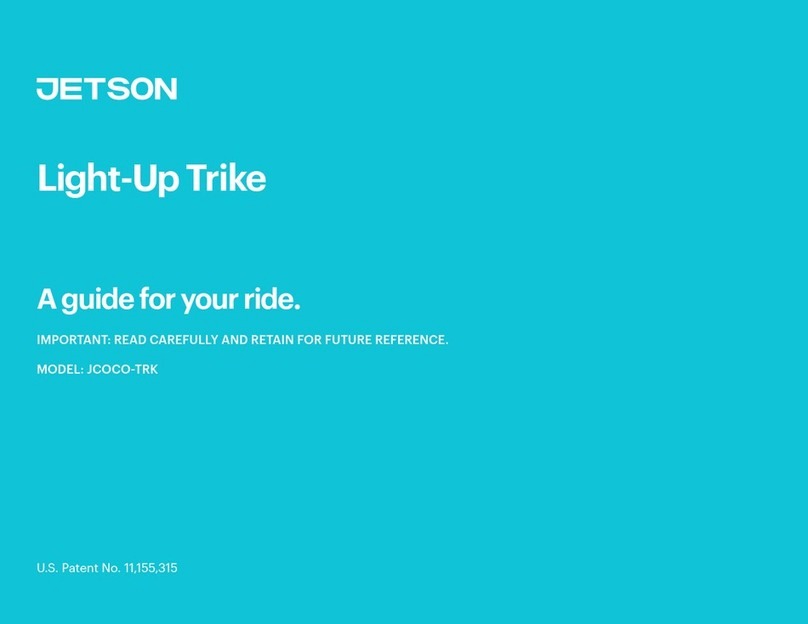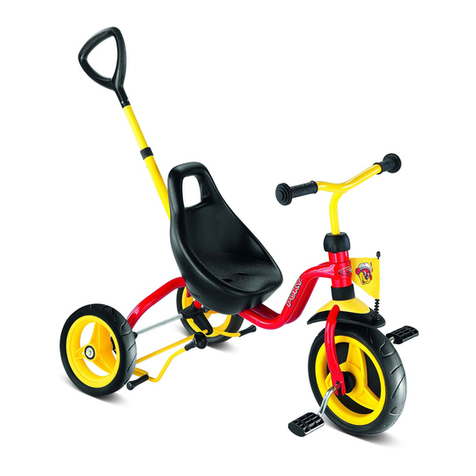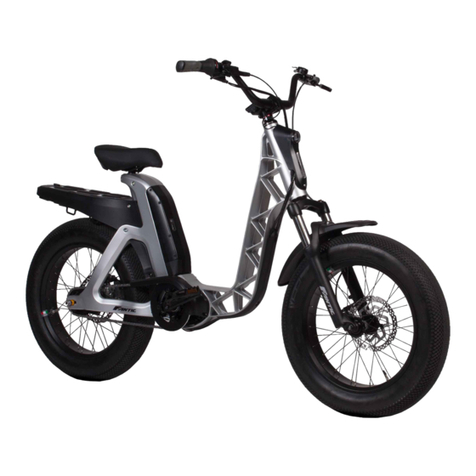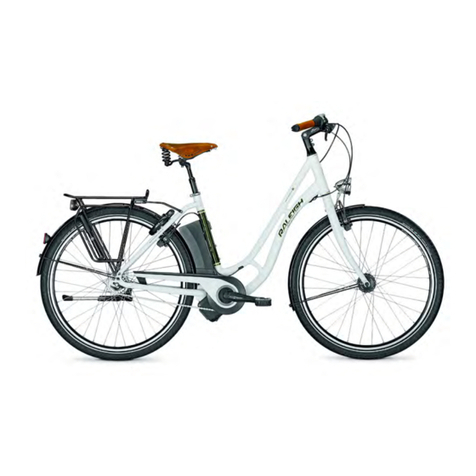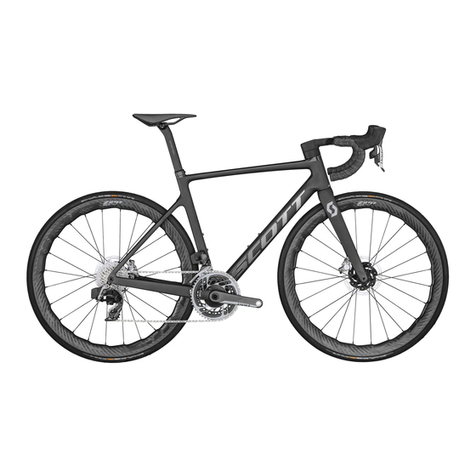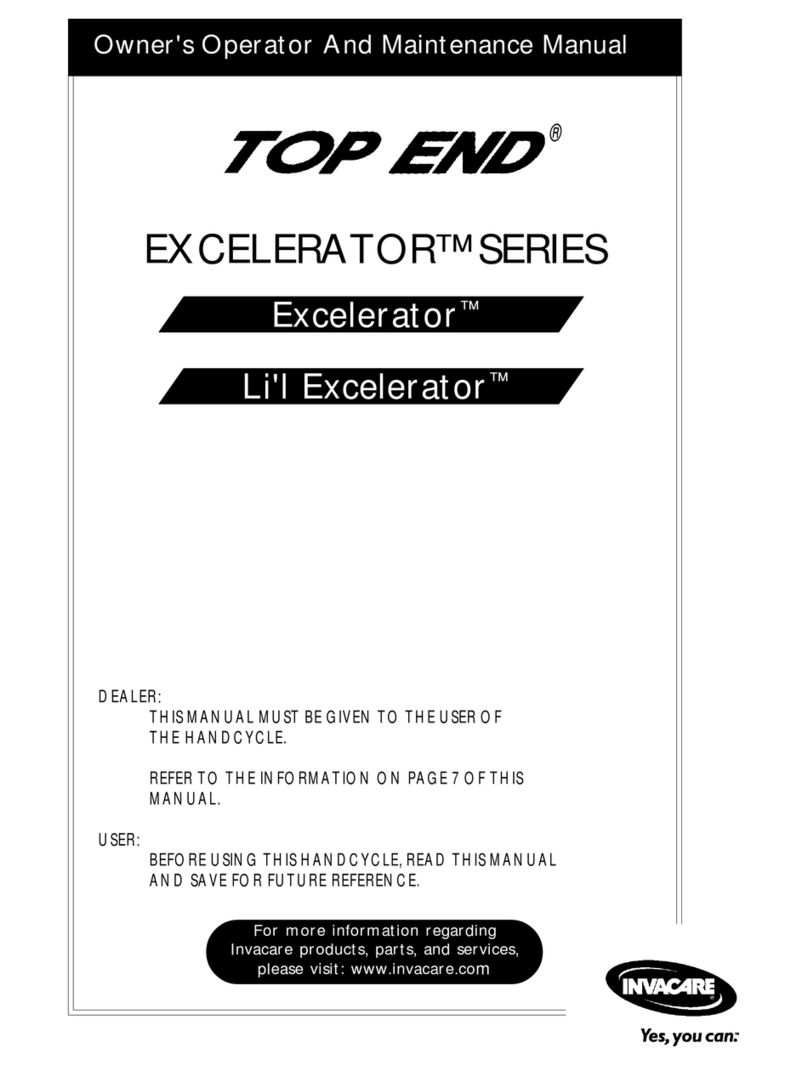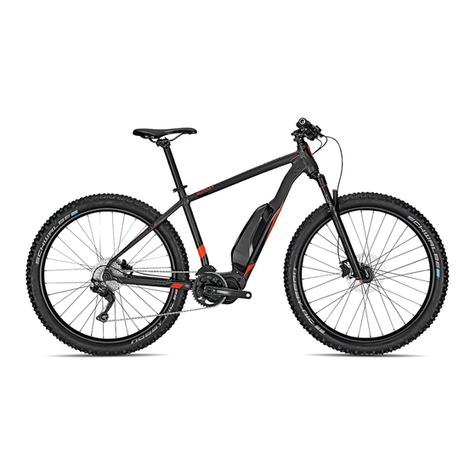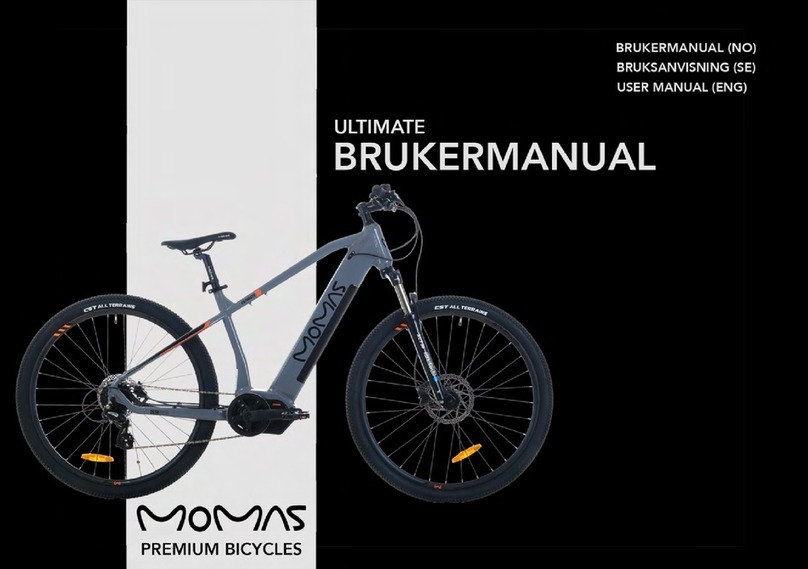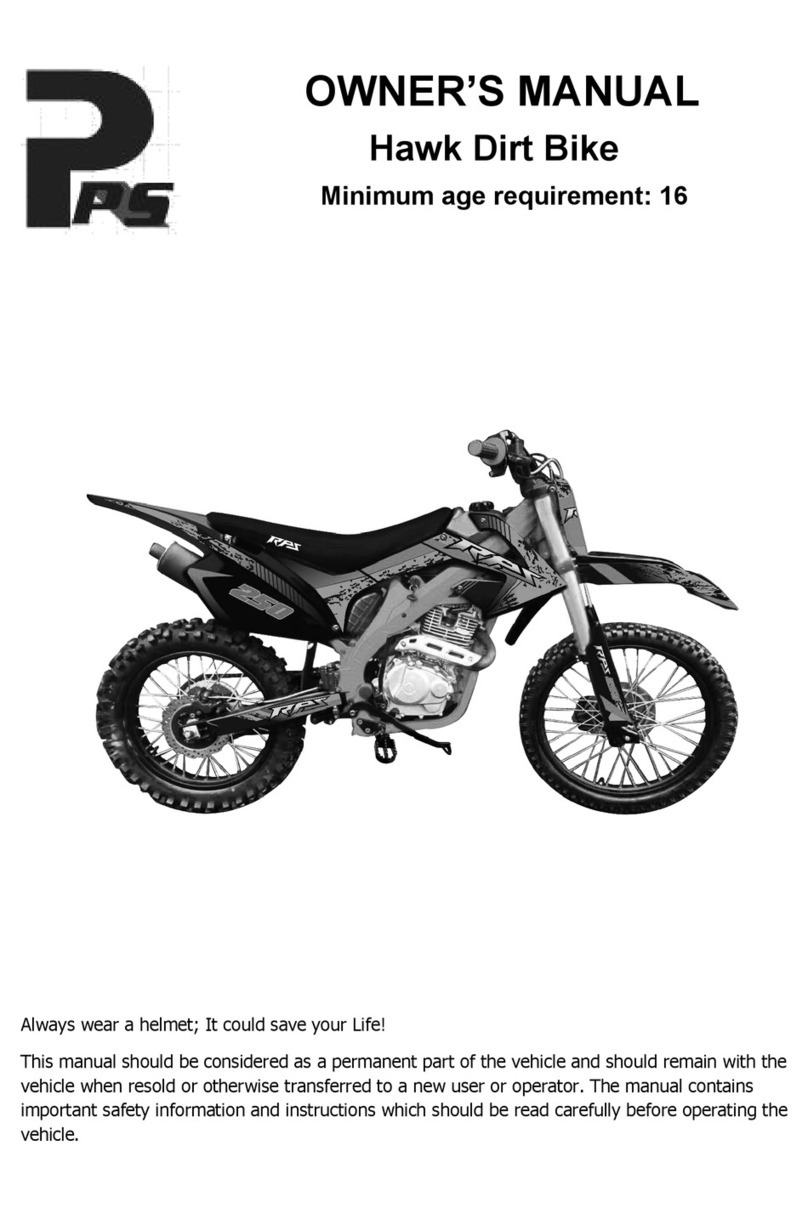SereneLife SLBKBLU28 User manual


www.SereneLifeHome.com2
THIS MANUAL CONTAINS IMPORTANT SAFETY, PERFORMANCE AND MAINTENANCE INFORMATION.
READ THE MANUAL BEFORE TAKING YOUR FIRST RIDE ON YOUR NEW BICYCLE,
AND KEEP THE MANUAL HANDY OF FUTURE REFERENCE
CONTENTS
Parts List 3-4
Installation Instructions 5-7
Maintenance Instructions 8
Safety Checklist 9-12
Safety Information 13-15
Correct tting
Make sure your helmet
covers your forehead.
Incorrect tting
Forehead is exposed and
vulnerable to serious injury.

www.SereneLifeHome.com 3
PARTS LIST
High-End Kid's Bicycle
Get to know the parts of your bicycle.This will help with assembly, maintenance, and troubleshooting.
Models vary in color and style.
Caution: Over-tightening of stem bolts or other clamping devices may cause injury to the rider

www.SereneLifeHome.com4
PRODUCT INFORMATION
Product Color: Black/Bule/Orange
Main Materials: Magnesium alloy, Steel, PP
Applicable Age: 4 years old and above
Execution Standards:
16 CFR Part 1512,CPSIA 101 (Lead),
16 CFR Part 1501,16 CFR Part 1500.20
PRODUCT FEATURES:
•High strength, lightweight and corrosion resistant
•One-piece formed magnesium alloy, stylish appearance
•Balance training wheels, three points of support, safe and stable
PARTS LIST:
A. Handlebar X1
B. Frame X1
C. Pedal X2
D. Training Wheel X2
E. Multi-function tool X1
F. Hexagonal Key X1
G. Kickstand X1
H. Front/Rear Reector X1

www.SereneLifeHome.com 5
INSTALLATION INSTRUCTIONS
Install Training Wheels
Install Kickstand
•Use multi-function tool to remove the nuts and spacers from
the left and right sides of the rear wheel.
•Install the training wheels, spacers and nuts in order as
shown in the diagram and lock them in place with a multi-
function tool. (The locking torque is not less than 18N.m)
•Training wheel height from the ground between 0.5-1cm is
best, before riding must conrm that all screws have been
tightened.
•Remove the nut with a wrench and take o both sides of
the training wheels.
•Install the kickstand into the corresponding frame screw
hole and tighten the nut with a wrench.
•Check the kickstand retraction and stand function.
Suggestion:
Install the kickstand after the user has mastered the balance

www.SereneLifeHome.com6
Install Pedal
Install Front/Rear Reector
•Use multi-function tool to remove the nuts and spacers from
the left and right sides of the rear wheel.
•Install the training wheels, spacers and nuts in order as
shown in the diagram and lock them in place with a multi-
function tool. (The locking torque is not less than 18N.m)
•Training wheel height from the ground between 0.5-1cm is
best, before riding must conrm that all screws have been
tightened.
•Remove the nut with a wrench and take o both sides of
the training wheels.
•Install the kickstand into the corresponding frame screw
hole and tighten the nut with a wrench.
•Check the kickstand retraction and stand function.
Suggestion:
Install the kickstand after the user has mastered the balance
•Put the corresponding L/R pedals into the corresponding left
and right cranks, and use a multi-function tool to turn and
lock in the direction of the front wheel (the locking torque is
not less than 45N.m).
•Install the front reector (white) on the handlebar as shown
in the picture, lock it with a screwdriver.
•Install the rear reector (red) on the seat tube as shown in
the picture, and lock it with a screwdriver.

www.SereneLifeHome.com 7
Install Handlebar •Remove the waterproof plug from the installed handlebar.
•Pull o the assembled handlebar protector, insert it into the
fork hole, adjust the angle (the center point of the handlebar
is perpendicular to the front wheel), make sure you can
insert the handlebar below the safety line into the head
tube of the frame, and lock it tight with hexagonal key.
•Make sure the handlebars are locked tight and do not move
from side to side (the locking torque is not less than 12N.m)
•Put the waterproof plug back in its original position.
•Put the corresponding L/R pedals into the corresponding left
and right cranks, and use a multi-function tool to turn and
lock in the direction of the front wheel (the locking torque is
not less than 45N.m).
•Install the front reector (white) on the handlebar as shown
in the picture, lock it with a screwdriver.
•Install the rear reector (red) on the seat tube as shown in
the picture, and lock it with a screwdriver.

•Remove the waterproof plug from the installed handlebar.
•Pull o the assembled handlebar protector, insert it into the
fork hole, adjust the angle (the center point of the handlebar
is perpendicular to the front wheel), make sure you can
insert the handlebar below the safety line into the head
tube of the frame, and lock it tight with hexagonal key.
•Make sure the handlebars are locked tight and do not move
from side to side (the locking torque is not less than 12N.m)
•Put the waterproof plug back in its original position.
www.SereneLifeHome.com8
MAINTENANCE INSTRUCTIONS
Adjusting Calliper Brakes
Throughout the life of your bike, the front calliper brakes may need adjusting if the brake cable has streched or the brake arms
have been knocked during use.
Adjusting the Caliper Cable Tension
1a
1a. Adjust the Brake Cable
The brake cable must be adjusted to ensure that the
brakes are close as possible to the wheel rim when no
pressure is applied to the brake lever but still allowing
freedom of wheel to rotate.
Using a suitable spanner or socket, loosen the cable
anchor nut until the brake inner wire/or cable is free to
move.
Pull the brake cable until the brake pads are approximately
3 to 4 mm from the wheel rim. Retighten the cable anchor
nut while holding the brake cable position.

1a. Adjust the Brake Cable
The brake cable must be adjusted to ensure that the
brakes are close as possible to the wheel rim when no
pressure is applied to the brake lever but still allowing
freedom of wheel to rotate.
Using a suitable spanner or socket, loosen the cable
anchor nut until the brake inner wire/or cable is free to
move.
Pull the brake cable until the brake pads are approximately
3 to 4 mm from the wheel rim. Retighten the cable anchor
nut while holding the brake cable position.
www.SereneLifeHome.com 9
SAFETY CHECKLIST
Before Riding
You should perfonn the following checks before riding your bike to ensure it is safe to use and operating correctly.
1. Is the saddle Secure?
While standing next to the bike, try and move the saddle from side to side.
If the saddle moves you should retighten the seat post bolt or the saddle clamp bolts.
2. Are the Front and Rear Tires Inated Correctly?
Squeeze the sides of the front and rear tires. If they are soft they will need inating.
Re-inate to the pressure indicated on the sides of the tires using approved bicycle pump.
3. Are the Pedals Tight?
Using the supplied multi-tool, ensure both the left and right pedals are fully tight.
Remember that the threaded shafts of the left and right pedals tighten in dierent directions.

www.SereneLifeHome.com10
4. Do the Brakes Work?
Stand next to the bike and apply the front brake and push forwards. If the wheels move, the front brake may not be
working correctly. If required, adjust the front brakes as described in the User Manual.
Repeat the above check for the rear brake.
5. Do the Handlebars Move?
Hold the front wheel between your legs and try to move the handlebars. If the handlebars move, the stem bolt may have
become loose. Retighten the stem bolt.
6. Is the bike Clean?
The bike should be cleaned and re-oiled regularty to ensure it operates correctly.
Using the Brakes
This bike is tted with a front clamp brake and a rear coaster brake to stop the bike eectively.
The breaks are operated using one brake lever mounted on the handlebar.
The left-hand brake lever operates the front brake.

www.SereneLifeHome.com 11
Riding In Bad Weather
WARNING! Wet weather impairs traction, braking and visibility, both for the bicyclist and for other vehicles
sharing the road. The risk of an accident is dramatically increased in wet conditions.
When riding in bad weather i.e. wet, foggy, windy or icy, always wear bright, reective clothing which is warm and waterproof.
You should always give other road users clear signals in plenty of time particularly when approaching junctions.
To make sure that you can slow down and stop safely in wet conditions, ride more slowly and apply your brakes earlier and
more gradually than you would under normal, dry conditions.
Be aware that all types of surface become greasy or slippery in bad weather. Do not turn or brake suddenly.
Riding in the Dark
WARNING! When riding in the dark, always make sure that the bike is tted with suitable reectors and a
white front light and a red rear light.
It is essential that other road users can clearly see you when riding in the dark. Always wear bright, reective clothing.
Suitable reectors should be tted to the front and rear of the bike and if possible the wheels. A white light must be tted to
the front of the bike and a red light at the rear.

www.SereneLifeHome.com12
Before starting any journey in the dark or even twilight,
ensure the lights are working correctly and are turned on.
Clean lights and reectors regularly and make sure they
can be seen from distance.
Riding Using Personal Music Players
Listening to music while biking or running roadside
presents danger, as headphones and earbuds impair one
of your most important senses -- hearing.
These devices prevent you from hearing approaching
vehicles and may prove to be a distraction.
They mask trac sounds and emergency vehicle sirens,
distract you from concentrating on what’s going on
around you, and their wires can tangle in the moving
parts of the bicycle, causing you to lose control.

www.SereneLifeHome.com 13
SAFETY INFORMATION
IMPORTANT - PLEASE FULLY READ THESE INSTRUCTIONS
WARNING! This Bike has been designed, assembled and tested in accordance with the16 CFR Part 1512, CPSIA 101 (Lead),
16 CFR Part 1501, 16 CFR Part 1500.20 standard to ensure your safety. To make sure the bike remains safe, it should only be
used for recreational use. Under no circumstances should it be used for competitive cycling, stunting, jumping or acrobatic
manoeuvres. These types of cycling may result in serious personal injury and damage to the bike.
WARNING! The bicycle is not suitable for the tting of a luggage carrier and a child seat.
The bicycle is not designed for public roads use.
WARNING! Always wear a properly tted helmet when you ride your bicycle.
WARNING! Wear something that reects light, such as reective tape or markings, or ashing lights.
All bikes need a bright white front light and a red rear light.
WARNING! Under wet conditions, the stopping power of your brakes (as well as the brakes of other vehicles sharing the
road) is dramatically reduced and your tires don’t grip nearly as well.This makes it harder to control speed and easier to lose
control.To make sure that you can slow down and stop safely in wet conditions, ride more slowly and apply your brakes
earlier and more gradually than you would under normal, dry conditions.
WARNING! Always wear bright, visible clothing that is not so loose that it can be tangled in the bicycle or snagged by
objects at the side of the road.

www.SereneLifeHome.com14
WARNING! This bike is only suitable for use by riders (including any panniers and/or luggage) with a weight or less than
(1) 30kgs (66 Ib) for 12in bikes, (2) 40kgs (88 Ib) for 14in bikes and (3) 50kgs (110 Ib) for 16in bikes.
WARNING! Please follow riding speed: (1) 12in bikes: 12km/hour, (2) 14in bikes:15km/hour, (3) 16in bikes: 18km/hour.
WARNING! The front and the rear tires must fully inated before attempting to ride the bike. Under no circumstances
should the tires be inated above the maximum pressure stated on the side of the tires.
WARNING! If any section of the wheel rim wear grove is no longer visible, the wheel rim should be replaced immediately.
Do not attempt to ride the bike until the rim is replaced as the braking performance could be aected.
WARNING! As with all mechanical components, the bike is subjected to wear and high stresses.
Dierent materials and components may react to wear, stress or fatigue in dierent ways. If the design life of a component
has been exceeded, it may suddenly fall, possibly causing injuries to the rider. Any form of crack, scratches or change of
colouring in highly stressed areas indicate that the life of the component has been reached and it should be replaced.
WARNING! Ensure only genuine replacement parts are used, especially for safety critical parts.
CAUTION! Only use suitable tools to assemble the bike.The use of unsuitable tools may lead to personal injury and
damage to the bike.
CAUTION! The safety and smooth running of the bike can only be preserved with regular maitenance.
Always ensure the bikes is maintained in accordance with this maintenance manual.

www.SereneLifeHome.com 15
CAUTION! If the gears make a grinding sound while riding the bike, STOP immediately.
The bike may be unsafe and prolonged use may lead to personal injury or damage to the bike.
Inspect and, if required, repair the bike before reusing.
CAUTION! Do not clean your bike with pressure washers. These high pressure cleaning devices may remove lubricant
and/or grease from bearing and internal bike parts. This may lead to poor performance.
CAUTION! When lubricating the moving parts of the bike, take care not to get any lubricant on the rims of the wheels or
the brake pads.

www.SereneLifeHome.com16

www.SereneLifeHome.com 17
This manual suits for next models
8
Table of contents

